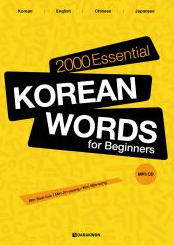Book review: 2000 Essential Korean Words for Beginners
 When this author arrived in Korea and started studying the language in 1996, there were not very many good books available, apart from those tied to university courses. For those wanting to go it alone, there was little around. Now with the popularity of learning Korean on the rise - more than 150,000 non-Koreans took the Test of Proficiency in Korean (TOPIK) this year - it seems that many publishers are putting out teaching and study materials.
When this author arrived in Korea and started studying the language in 1996, there were not very many good books available, apart from those tied to university courses. For those wanting to go it alone, there was little around. Now with the popularity of learning Korean on the rise - more than 150,000 non-Koreans took the Test of Proficiency in Korean (TOPIK) this year - it seems that many publishers are putting out teaching and study materials.
Here is a useful book just released this year for anyone in their first year or two of seriously studying the language. The title is straightforward enough: 2000 Essential Korean Words for Beginners. Though not a large book, it has considerable heft -just over 500 pages, and there's a CD stuck inside the back. More about that later.
The book is by three authors: Ahn Seol-hee, Min Jin-young and Kim Min-sung all with Masters degrees from Yonsei University in teaching Korean as a foreign language. They have certainly done their homework. In choosing 2,000 "essential" words for beginners, the perennial difficulty is deciding which words. The authors have used a tripartite rule. Every word here matches one or more of three criteria: they have appeared in 3 or more Korean language textbooks of nine universities and two private language institutes; they have appeared in the grammar/vocabulary section of the TOPIK; or they are on the list of basic level words for learners of Korean made by the National Institute of the Korean language. This ensures that the words are commonly taught, and hopefully also commonly used.
The book is divided into 14 thematic chapters, for example, "People," "Everyday Life" and "Economic Activities." Each chapter is then divided into sections, and each section is followed by a self-test to aid the memory. The 2,000 words themselves are presented with a translation (in English, Chinese and Japanese) as well as an example sentence, and further information including conjunctions, collocations, parts of speech and antonyms. The example sentences are good, and every word and example sentence is recorded by a Korean speaker on one of 64 tracks on the audio CD (one track for each section of the book). This is good for later revision without looking at the text. On the publisher's website (www.darakwon.co.kr) you can find the tracks downloadable in MP3 format, as well as details of other books and promotions.
At the end of each chapter there is a page called "Korean Through Chinese Characters," useful because some 50-70 percent of Korean vocabulary has been borrowed from Chinese. On the page, five to six words are presented which each contain the same Chinese character. Again, translations are given in the three languages, and example sentences too.
The back of the book has a nifty appendix with groups of words best learned together - colors, body parts, verbs related to clothing, and so on. There is also a big list of irregular verbs and how they are all conjugated. Finally, the book contains an exhaustive index - key to any good learning book.
The book is attractively and clearly presented. It can be used alongside any textbook or course, for TOPIK preparation, revision or just for vocabulary building. The only drawback as this author sees it is that while the Japanese and Chinese translations of words are given, the Chinese characters used in Korean are not. This is even on the "Korean Through Chinese Characters" pages. While the importance of Chinese characters in Korean is on the wane, it is good to see them in a reference book like this, because Korean does not always use the same characters as the other two languages, even for the same words (the word for "careful" is a good example).
Overall, this book is well worth its price tag for those learning Korean. And don't be surprised if, even after several years of study, there are still some words lurking within that you don't yet know. It's definitely worth a look.
By Jacco Zwetsloot
Korea.net Staff Editor

